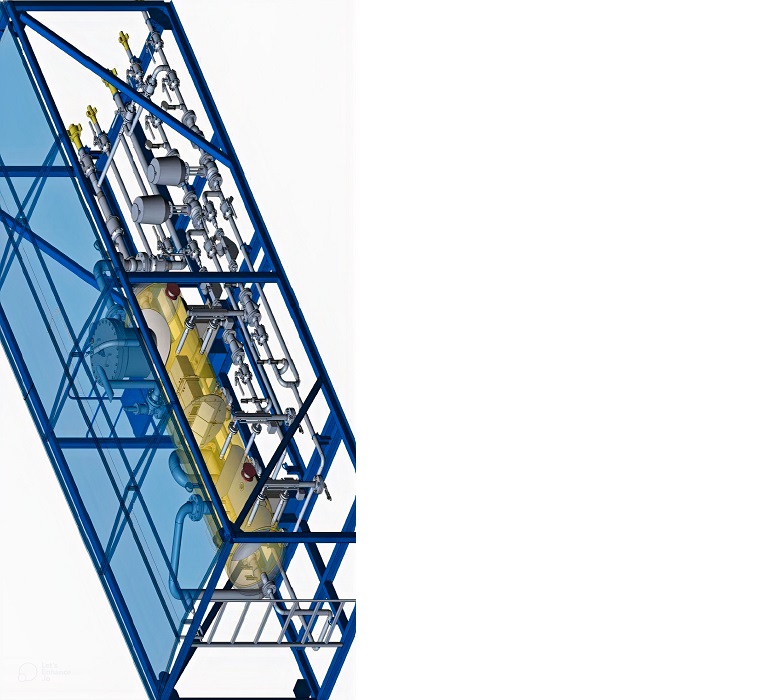Ефективність технології підготовки газу з використанням блочної установки осушки
DOI:
https://doi.org/10.15587/1729-4061.2023.288225Ключові слова:
фреонова холодильна установка, осушка газу, сепарація, термін окупності, газорозподільча системаАнотація
Об’єктом дослідження є технологія осушки газу за допомогою мобільної блочної установки. Вирішено проблему забезпечення відповідності складу природного видобувного газу значенням ряду основних характеристик перед його подачею до магістральних трубопроводів. Представлені результати комплексного аналізу технології підготовки газу родовища, котре розташоване у сільськогосподарському районі та перебуває на пізньому етапі експлуатації. Встановлено, що для забезпечення подачі кондиційного газу в систему магістральних газопроводів за умови низьких тисків газу потрібно будівництво установок по обробці газу, в першу чергу – по його осушенню.
Розглядуваний у роботі метод забезпечення якості газу передбачає використання установки осушки газу блочного типу в складі установки низькотемпературної сепарації та джерела штучного холоду. В якості останнього передбачається використання фреоново-холодильної установки. У дослідженні показано, що запропоновані блочні установки осушки газу можуть бути уніфікованими для різної продуктивності по газу та характеризуються порівняно невеликими капітальними та експлуатаційними витратами. Наведено основні переваги запровадження блочних установок підготовки газу та схему підключення установки до існуючої лінії.
За результатами показників економічної ефективності встановлено, що застосування блочної установки осушки газу є окупним проєктом зі значенням накопиченого приведеного вільного грошового потоку у майже 843 тисячі умовних одиниць. та терміном окупності інвестицій 3 роки. Отримані результати можна ефективно використовувати у газорозподільчій сфері за умови, що газ видобувається з близького до виснаження родовища, яке характеризується низькими пластовими тисками
Посилання
- Biletskyi, V. S., Orlovskyi, V. M., Vitryk, V. H. (2018). Osnovy naftohazovoi inzheneriyi. Poltava: ASMI, 415. Available at: https://repository.kpi.kharkov.ua/items/7178193a-9948-4638-924f-657cbb91366c
- Mykhailov, V. A., Vakarchuk, S. H., Zeikan, O. Yu., Kasianchuk, S. V., Kurovets, I. M., Vyzhva, S. A. et al. (2014). Netradytsiyni dzherela vuhlevodniv Ukrainy. Kyiv: Nika-Tsentr, 280. Available at: http://elar.nung.edu.ua/handle/123456789/5162
- Agarwal, P., Patel, P., Jain, S. (2013). Installation of Unique & First of Its kind, Gas Enrichment Plant - Natural Gas Purification and Drying Unit to Remove the Excessive Quantity of Nitrogen, Carbon Dioxide & Helium from the Natural Gas Produced at the Marginal Gas Fields of Rajasthan, India. Proceedings of SPE Asia Pacific Oil & Gas Conference and Exhibition. doi: https://doi.org/10.2118/165741-ms
- Jin, L., Hawthorne, S., Sorensen, J., Pekot, L., Bosshart, N., Gorecki, C. et al. (2017). Utilization of Produced Gas for Improved Oil Recovery and Reduced Emissions from the Bakken Formation. SPE Health, Safety, Security, Environment, & Social Responsibility Conference. doi: https://doi.org/10.2118/184414-ms
- Kravchenko, S., Popov, S., Gnitko, S. (2016). The working pressure research of piston pump RN-3.8. Eastern-European Journal of Enterprise Technologies, 5(1 (83)), 15–20. doi: https://doi.org/10.15587/1729-4061.2016.80626
- Sivanandam, S., Al Ali, M. (2020). Capturing in Gas Treating Plants Technology Review and Selection. Abu Dhabi International Petroleum Exhibition & Conference. doi: https://doi.org/10.2118/203479-ms
- Saha, C. K., Sabbir, A. S. M. Y. B., Sarker, S., Alam, Md. M. (2020). Development and Evaluation of LPG Based Heating System for BAU-STR Dryer. 2020 ASABE Annual International Virtual Meeting. doi: https://doi.org/10.13031/aim.202000780
- Orymbetov, E., Orymbetova, G. E., Khussanov, A. E., Orymbetov, T. E., Orymbetov, B. E. (2022). Sectioning of petroleum gas adsorption drying. Series of geology and technical sciences, 3 (453), 155–165. doi: https://doi.org/10.32014/2022.2518-170x.187
- Laing, W. (2003). Rising to the rural challenges. Petroleum review (London. 1968). MAR, 26–28.
- Liashenko, A., Makarenko, V., Vynnykov, Y., Petrash, O. (2021). Oil wells hydrate formation regularities. Eastern-European Journal of Enterprise Technologies, 3 (6 (111)), 19–24. doi: https://doi.org/10.15587/1729-4061.2021.233511

##submission.downloads##
Опубліковано
Як цитувати
Номер
Розділ
Ліцензія
Авторське право (c) 2023 Oleksandr Petrash, Stanislav Popov, Ruslan Petrash, Yuliia Levchenko, Anton Kelemesh

Ця робота ліцензується відповідно до Creative Commons Attribution 4.0 International License.
Закріплення та умови передачі авторських прав (ідентифікація авторства) здійснюється у Ліцензійному договорі. Зокрема, автори залишають за собою право на авторство свого рукопису та передають журналу право першої публікації цієї роботи на умовах ліцензії Creative Commons CC BY. При цьому вони мають право укладати самостійно додаткові угоди, що стосуються неексклюзивного поширення роботи у тому вигляді, в якому вона була опублікована цим журналом, але за умови збереження посилання на першу публікацію статті в цьому журналі.
Ліцензійний договір – це документ, в якому автор гарантує, що володіє усіма авторськими правами на твір (рукопис, статтю, тощо).
Автори, підписуючи Ліцензійний договір з ПП «ТЕХНОЛОГІЧНИЙ ЦЕНТР», мають усі права на подальше використання свого твору за умови посилання на наше видання, в якому твір опублікований. Відповідно до умов Ліцензійного договору, Видавець ПП «ТЕХНОЛОГІЧНИЙ ЦЕНТР» не забирає ваші авторські права та отримує від авторів дозвіл на використання та розповсюдження публікації через світові наукові ресурси (власні електронні ресурси, наукометричні бази даних, репозитарії, бібліотеки тощо).
За відсутності підписаного Ліцензійного договору або за відсутністю вказаних в цьому договорі ідентифікаторів, що дають змогу ідентифікувати особу автора, редакція не має права працювати з рукописом.
Важливо пам’ятати, що існує і інший тип угоди між авторами та видавцями – коли авторські права передаються від авторів до видавця. В такому разі автори втрачають права власності на свій твір та не можуть його використовувати в будь-який спосіб.










